9教案情态动词
- 格式:docx
- 大小:14.20 KB
- 文档页数:5
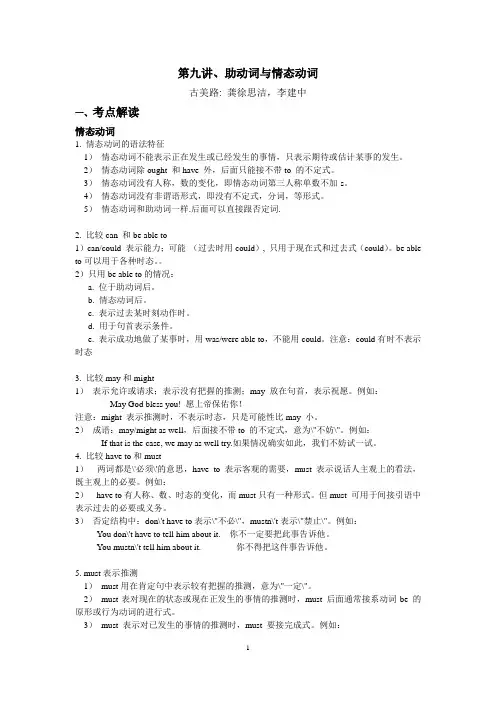
第九讲、助动词与情态动词古美路: 龚徐思洁,李建中一、考点解读情态动词1. 情态动词的语法特征1)情态动词不能表示正在发生或已经发生的事情,只表示期待或估计某事的发生。
2)情态动词除ought 和have 外,后面只能接不带to 的不定式。
3)情态动词没有人称,数的变化,即情态动词第三人称单数不加-s。
4)情态动词没有非谓语形式,即没有不定式,分词,等形式。
5)情态动词和助动词一样.后面可以直接跟否定词.2. 比较can 和be able to1)can/could 表示能力;可能(过去时用could), 只用于现在式和过去式(could)。
be able to可以用于各种时态。
2)只用be able to的情况:a. 位于助动词后。
b. 情态动词后。
c. 表示过去某时刻动作时。
d. 用于句首表示条件。
e. 表示成功地做了某事时,用was/were able to,不能用could。
注意:could有时不表示时态3. 比较may和might1)表示允许或请求;表示没有把握的推测;may 放在句首,表示祝愿。
例如:May God bless you! 愿上帝保佑你!注意:might 表示推测时,不表示时态,只是可能性比may 小。
2)成语:may/might as well,后面接不带to 的不定式,意为\"不妨\"。
例如:If that is the case, we may as well try.如果情况确实如此,我们不妨试一试。
4. 比较have to和must1)两词都是\'必须\'的意思,have to 表示客观的需要,must 表示说话人主观上的看法,既主观上的必要。
例如:2)have to有人称、数、时态的变化,而must只有一种形式。
但must 可用于间接引语中表示过去的必要或义务。
3)否定结构中:don\'t have to表示\"不必\",mustn\'t表示\"禁止\"。


Unit9 情态动词 I语法考点超级归纳考点一:情态动词的基本用法1. 情态动词的概念情态动词又称为情态助动词(Modal Auxiliary)。
它具有词汇意义,但意义不够完整,因此一般不能单独作谓语。
情态动词表示说话人的语气和态度。
2. 情态动词的特征情态动词具有以下五个特征:(1)情态动词后面一般接原形动词(即不带to的不定式);(2)情态动词没有人称和数的变化;(3)情态动词与其他动词构成谓语时总是放在其他动词之前;(4)情态动词无非谓语形式,即没有不定式、动名词和分词形式;(5)情态动词只有现在式和过去式两种形式,但可以表示现在时间、过去时间和将来时间。
3. 情态动词的意义常见的情态动词如下表所示:现代英语语法还将have to, used to, had better, would rather, be going to, be about to等也都列为情态动词。
考点二:表示“能力”的情态动词考点三:表示“允许”的情态动词注:注意:as well 在口语中常与may或might连用,作“也好,也行”或“倒不如”解,用来缓和语气。
例如:You may as well go. 你去也好。
The weather was so bad that we might(just)as well have stayed at home. 天气太糟糕,早知道如此,倒不如呆在家里为好。
考点四:表示“推测”的情态动词gate just a moment ago.h.考点五:“情态动词+have+过去分词”表示“过去推测”“can/could/may/must+have+过去分词”表示对过去情况的推测hat注意:could, might表示推测时不表示时态,其推测的程度不如can, may。
考点六:表示“应该”的情态动词注:考点七:表示“意愿”的情态动词wil考点八:“情态动词+have+过去分词”表示“责备”“情态动词+have+过去分词”表示已经完成的动作或存在的状态,并带有感情色彩。
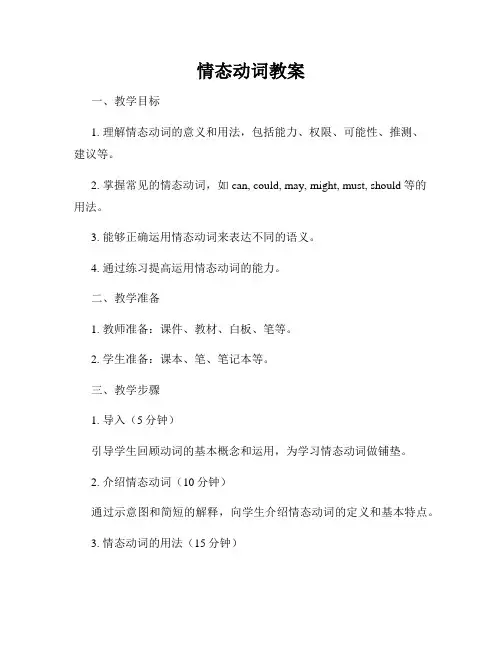
情态动词教案一、教学目标1. 理解情态动词的意义和用法,包括能力、权限、可能性、推测、建议等。
2. 掌握常见的情态动词,如can, could, may, might, must, should等的用法。
3. 能够正确运用情态动词来表达不同的语义。
4. 通过练习提高运用情态动词的能力。
二、教学准备1. 教师准备:课件、教材、白板、笔等。
2. 学生准备:课本、笔、笔记本等。
三、教学步骤1. 导入(5分钟)引导学生回顾动词的基本概念和运用,为学习情态动词做铺垫。
2. 介绍情态动词(10分钟)通过示意图和简短的解释,向学生介绍情态动词的定义和基本特点。
3. 情态动词的用法(15分钟)通过多个例句,讲解情态动词的不同用法,如表示能力、权限、可能性、推测和建议等。
4. 常用情态动词的用法(15分钟)介绍几个常用的情态动词,如can, could, may, might, must, should等,并给出相应的例句和用法解释。
5. 情态动词的练习(15分钟)让学生完成一些练习题,巩固对情态动词的掌握程度,同时培养运用情态动词的能力。
6. 情态动词的拓展运用(10分钟)鼓励学生在课堂上提出更多的例句和情态动词的用法,并进行讨论和分享。
7. 总结与评价(5分钟)总结本节课所学的内容,检查学生对情态动词的掌握情况。
四、课堂讨论在课堂上,教师可与学生进行互动性的讨论,如让学生用所学的情态动词来回答教师的问题,或者通过小组合作讨论,从不同的角度探讨情态动词的用法和意义。
五、拓展练习1. 在课堂上让学生完成一些情态动词的练习题,以培养他们的运用能力。
2. 布置一些家庭作业,要求学生写一篇文章,并在文章中运用情态动词来表达不同的意义和语境。
六、教学反思通过本节课的教学,学生能够理解情态动词的用法和意义,形成初步的运用能力。
在教学过程中,教师要注意引导学生主动思考、互动讨论,以巩固学生对情态动词的理解和应用。
此外,针对不同水平的学生,可以适当调整教学内容和难易程度,确保每个学生都能够受益于这堂课。
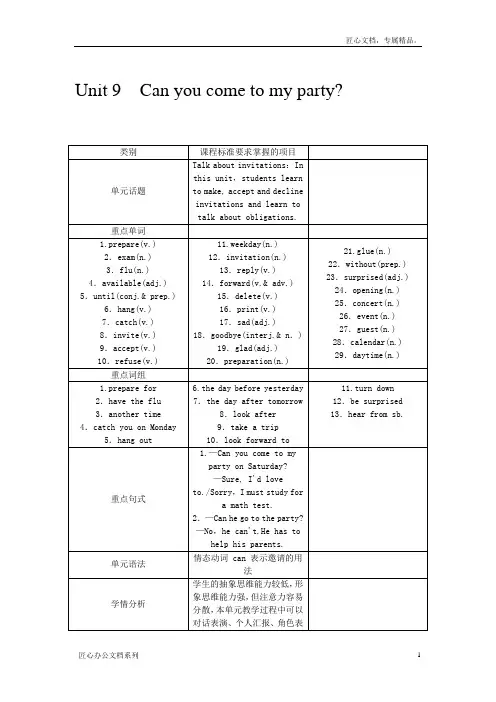
Unit 9Can you come to my party?第一课时Section A (1a~1c)§自主学习案根据句意及首字母提示完成单词。
1.She didn't go to school and stayed in bed because she had the f lu.2.Can you come and h elp me with my English?3.Can I m eet my friend tomorrow, Mom?4.I must go to see a d octor because I feel ill.5.My mother prepares for b reakfast for our family every morning.§课堂导学案Step 1准备与热身(Preparation)Hello,class.We are learning Unit 9 today.But first look at this sentence:Can you come to my party? What does it mean?You are correct. It means “你能来参加我的聚会吗?”“Can” means “能,行”. You may answer like these: Yes,I can.I can come to the party./No. I can't.I have to do my homework. In these sentences both can and have to are model verbs. They are part of the predicates.Can you come to school? Yes, I can./No, I can't.I have to see a doctor.Can you get to school by bus? Yes, I can./No, I can't.I have to walk.Step 2呈现与输入(Presentation)Please look at the picture on page 65. The boy in the middle is going to hold a party.Can everyone come to the party?Help my parents, prepare for an exam, meet my friends,have the flu, go to the doctor.Please read these expressions loudly. And match the words with the picture.Areyou OK? Let's check the answers.Step 3练习与体验(Practice)You are great ! As you see, there are some people in the picture.Do you know who's who?Now please listen to the conversation.Pay attention to Sun Ning's words carefully.He says the names of each person he is inviting. When I play the recording for the first time,you just listen carefully. When I play the recording for the second time,please write the names of each person next to his or her picture. You have to complete the activity on your own.OK, let's go!Now let's talk as they do in the conversation.In other words, we are going to talk in imitation of the conversation we have just heard and read.Step 4运用与生成(Production)Now please make your own dialogues in groups of four. Suppose you are the students in the picture. One of you is inviting the other three students to his party. The other students are saying if he can go or not.If you can't go, remember to give a reason.When you practice, please pay attention to the pronunciation and intonation.I'll offer vocabulary and pronunciation support if you need.Step 5巩固与提高(Progress)【探究点】Can you come to my party on Saturday afternoon? 你能在周六下午来参加我的聚会吗?Can you…?句型是熟人和朋友之间常用的表达邀请或请求的用语。
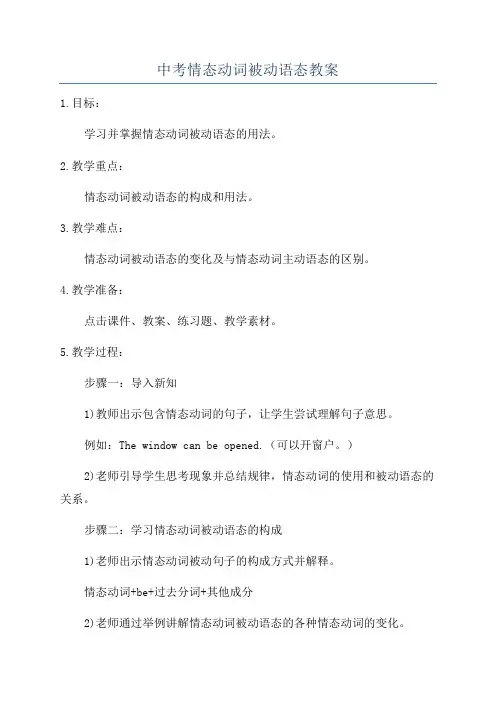
中考情态动词被动语态教案1.目标:学习并掌握情态动词被动语态的用法。
2.教学重点:情态动词被动语态的构成和用法。
3.教学难点:情态动词被动语态的变化及与情态动词主动语态的区别。
4.教学准备:点击课件、教案、练习题、教学素材。
5.教学过程:步骤一:导入新知1)教师出示包含情态动词的句子,让学生尝试理解句子意思。
例如:The window can be opened.(可以开窗户。
)2)老师引导学生思考现象并总结规律,情态动词的使用和被动语态的关系。
步骤二:学习情态动词被动语态的构成1)老师出示情态动词被动句子的构成方式并解释。
情态动词+be+过去分词+其他成分2)老师通过举例讲解情态动词被动语态的各种情态动词的变化。
Shall/should be done, will/would be done, can/could be done, may/might be done, must be done3)学生跟读并模仿老师的口头例句。
例如:The book will be read.(这本书会被读。
)Step3:巩固练习1)教师提供一些情态动词被动语态的练习题,让学生进行练习。
例如:- _____ you _____ to the party tomorrow?-No,I_____.2)学生分组合作完成练习题,并相互检查对答案。
步骤四:总结归纳老师引导学生就情态动词被动语态的构成及用法进行总结归纳。
6.作业布置:1)完成课堂上的练习题。
2)预习下一节课的内容。
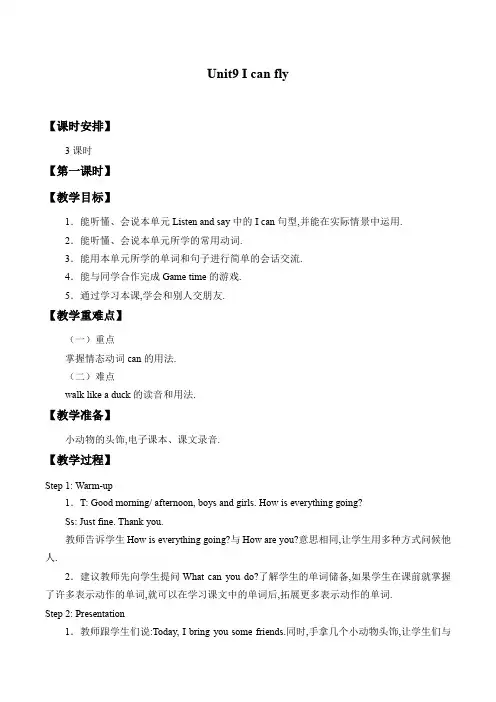
Unit9 I can fly【课时安排】3课时【第一课时】【教学目标】1.能听懂、会说本单元Listen and say中的I can句型,并能在实际情景中运用.2.能听懂、会说本单元所学的常用动词.3.能用本单元所学的单词和句子进行简单的会话交流.4.能与同学合作完成Game time的游戏.5.通过学习本课,学会和别人交朋友.【教学重难点】(一)重点掌握情态动词can的用法.(二)难点walk like a duck的读音和用法.【教学准备】小动物的头饰,电子课本、课文录音.【教学过程】Step 1: Warm-up1.T: Good morning/ afternoon, boys and girls. How is everything going?Ss: Just fine. Thank you.教师告诉学生How is everything going?与How are you?意思相同,让学生用多种方式问候他人.2.建议教师先向学生提问What can you do?了解学生的单词储备,如果学生在课前就掌握了许多表示动作的单词,就可以在学习课文中的单词后,拓展更多表示动作的单词.Step 2: Presentation1.教师跟学生们说:Today, I bring you some friends.同时,手拿几个小动物头饰,让学生们与Step6: Homework【第二课时】【教学目标】1.能听懂、会说本单元Let's act部分课文语言,并能在实际情景中运用.2.能听懂、会用I can...表达自己的能力,回答相关问题.3.能读懂Try to do的谜语,并能与伙伴们交流,写出答案.4.能用所学单词和句子进行简单的会话交流.5.能认读元音字母Ii,并了解其在单词中的基本发音及其简单的拼读规律.6.能听懂、会说绕口令:A little pig is fishing near the hill.7.通过学习本课,学会了解别人的长处,与别人合作,共同完成任务.【教学重难点】(一)重点能听懂、会说I can...并能在实际情景中运用.(二)难点听懂会说短语guard the door, make the bubbles, catch a mouse.【教学准备】美猴王的图片和头饰,写有动词或动词短语的纸条、课文录音、电子课本.教学过程Step 1: Warm-up1.教师发出指令,学生在座位上做动作.除了书中的指令之外,可以增加其他指令如:Walk like a cat. Swim like a fish. Run like a dog. Fly like a bird.等等.这个活动也可以在学习小组内进行,看哪组合作愉快.2.T: I can play ping-pong. What can you do?Ss: I can...教师要鼓励学生们都参与对话练习,也可以以小组形式进行.Step 2: Presentation1.建议教师出示美猴王孙悟空的头饰.这是个学生们熟悉的人物,教师可以让学生们先进行小组讨论,记录下他都能做些什么.然后,用What can he do? He can...做问答练习.教师应鼓励学生们畅所欲言.2.以小组为单位分角色朗读课文.学生们熟练后,可以让学生进行分角色表演.由一位学生表演孙悟空,其他学生练习与他对话,看哪组活动活跃、合作愉快.这个活动可多进行几组,直到学2.学习成果评价仿照例句,改写句子.(1)I can run very fast. I can't run very fast.He can swim. ________________________.(2)I can sing and dance. Can you sing and dance?She can play ping-pong. _________________________?(3)I can read and write. What can you do?My mother can speak English. ________________________? Step6: Homework【第三课时】【教学目标】1.能读懂Read and say短文,并能独立填补短文的空缺.2.能听懂、会说本单元所学有关can的各种句型并能在实际情景中运用.3.能听懂、会用I can...表达自己的能力,并能回答相关问题.4.能熟练朗读chant.5.能与同桌就Reward time内容进行自评和互评.6.通过本课学习,学会了解别人的长处,与别人合作,共同完成任务.【教学重难点】(一)重点能听懂、会说I can...并能在实际情景中运用.(二)难点会用I can...表达自己的能力,回答相关问题.【教学准备】老虎的图片和头饰,写有动词或动词短语的图片、课文录音、电子课本.【教学过程】Step 1: Warm-up1.教师组织学生们把自己编写的新谜语与大家分享,可以先在小组内交流,然后推选一人参加班级展示,看谁的新谜语编得最好.2.说绕口令比赛.比赛可在小组之间进行,小组成员先站立,每人都说绕口令,说错的请坐下.看谁站到最后,谁是获胜者.Step 2: Presentation1.教师先介绍小老虎,让学生列出小老虎能做的事情,再引导学生和同桌阅读Read and say,经过讨论理解后,将空缺之处补充完整,使短文完整、正确.2.建议教师以自由问答的方式和学生共同总结我们人类能够做的事情,让学生畅所欲言.3.教师再引导学生和同桌合作朗读课文Read and say.学生自行练习后,选择一组学生示范朗读,教师纠正出现错误的地方.4.教师鼓励学生以同桌的形式合作表演Read and say,看哪组表演得最好.5.出Let's chant部分图片.教师一边读句子,一边做夸张动作.然后,让学生模仿教师做动作,待学生熟练后,教师指导学生朗读chant,使每个学生都能流畅读出歌谣.6.请学生听录音,跟读chant,学生逐句跟读歌谣,再复述歌谣.此时,应该有些学生可以复述下来了,对于这样的学生要及时表扬和鼓励,并顺势把这个任务作为课后作业布置下去.Step 3: Practice2.学习成果评价完成句子.(1)I can ______ (run) very fast, but I ______ swim.(2)I can sing ______ dance, but I can't ______ (play) ping-pong.(3)I can read and write. And I can ______ (speak) English. Step6: Homework。
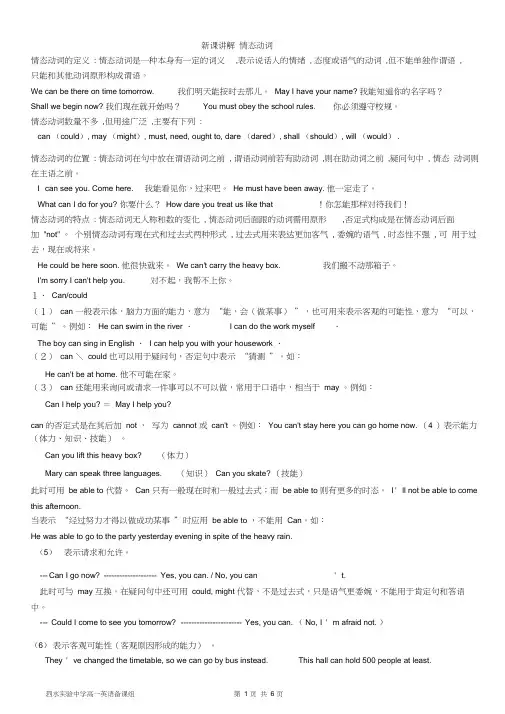
新课讲解情态动词情态动词的定义: 情态动词是一种本身有一定的词义,表示说话人的情绪, 态度或语气的动词,但不能单独作谓语,只能和其他动词原形构成谓语。
We can be there on time tomorrow. 我们明天能按时去那儿。
May I have your name? 我能知道你的名字吗?Shall we begin now? 我们现在就开始吗?You must obey the school rules. 你必须遵守校规。
情态动词数量不多,但用途广泛,主要有下列:can (could), may (might), must, need, ought to, dare (dared), shall (should), will (would) .情态动词的位置: 情态动词在句中放在谓语动词之前, 谓语动词前若有助动词,则在助动词之前,疑问句中, 情态动词则在主语之前。
I can see you. Come here. 我能看见你,过来吧。
He must have been away. 他一定走了。
What can I do for you? 你要什么?How dare you treat us like that !你怎能那样对待我们!情态动词的特点: 情态动词无人称和数的变化, 情态动词后面跟的动词需用原形,否定式构成是在情态动词后面加"not" 。
个别情态动词有现在式和过去式两种形式, 过去式用来表达更加客气, 委婉的语气, 时态性不强, 可用于过去,现在或将来。
He could be here soon. 他很快就来。
We can't carry the heavy box. 我们搬不动那箱子。
I'm sorry I can't help you. 对不起,我帮不上你。
1.Can/could(1)can 一般表示体,脑力方面的能力,意为“能,会(做某事)”,也可用来表示客观的可能性,意为“可以,可能”。
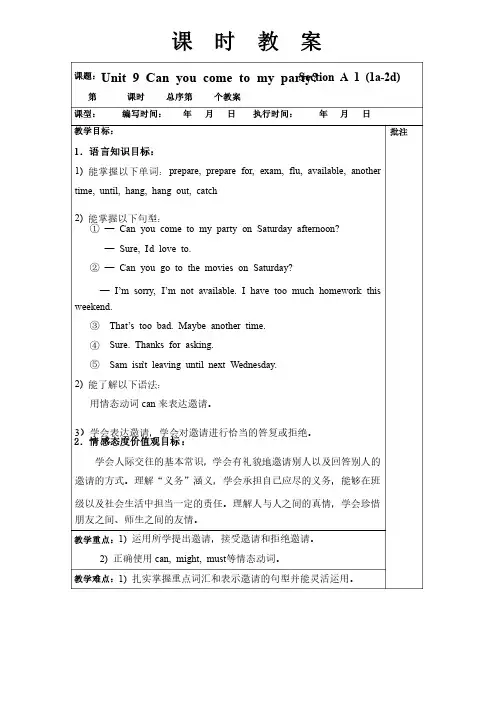
课时教案课题:Unit 9 Can you come to my party? Section A 1 (1a-2d)第课时总序第个教案课型:编写时间:年月日执行时间:年月日教学目标:1. 语言知识目标:1) 能掌握以下单词:prepare, prepare, prepare prepare prepare for, for, for, exam, exam, exam, flu, flu, flu, available, available, available, another another time, until, hang, hang out, catch 2) 能掌握以下句型:①—Can you come to my party on Saturday afternoon? —Sure, I’d love to. ②—Can you go to the movies on Saturday? —I ’m m sorry, sorry, sorry, I I ’m m not not not available. available. available. I I I have have have too too too much much much homework homework homework this this weekend. ③That That’’s too bad. Maybe another time. ④Sure. Thanks for asking. ⑤Sam isn ’t leaving until next Wednesday. 2) 能了解以下语法:用情态动词can 来表达邀请。
3)学会表达邀请,学会对邀请进行恰当的答复或拒绝。
2. 情感态度价值观目标:学会人际交往的基本常识,学会人际交往的基本常识,学会有礼貌地邀请别人以及回答别人的学会有礼貌地邀请别人以及回答别人的邀请的方式。

人教版九年级下册英语全册教案一、教学目标1.让学生掌握本册书的核心词汇、短语和句型,提高学生的英语综合运用能力。
2.培养学生的听说读写技能,提高学生的英语实际运用能力。
二、教学内容1.Unit1-3:重点学习动词时态、被动语态、宾语从句等语法知识。
2.Unit4-6:重点学习情态动词、条件句、祈使句等语法知识。
3.Unit7-9:重点学习名词性从句、定语从句、状语从句等语法知识。
4.Unit10-12:重点学习过去进行时、过去完成时、过去将来时等语法知识。
Unit11.教学目标:学习一般过去时的动词变化,掌握过去进行时和过去完成时的区别。
2.教学重点:一般过去时的动词变化,过去进行时和过去完成时的运用。
3.教学难点:过去进行时和过去完成时的区别。
4.教学步骤:Step1:导入通过图片或故事引入本课主题,激发学生的学习兴趣。
Step2:讲解语法讲解一般过去时的动词变化,过去进行时和过去完成时的用法。
Step3:课堂练习学生进行课堂练习,巩固所学知识。
Step4:小组讨论学生分组讨论,运用所学知识进行实际交流。
Unit21.教学目标:学习情态动词can、may、must等,掌握其用法和区别。
2.教学重点:情态动词can、may、must的用法。
3.教学难点:情态动词的区别和实际运用。
4.教学步骤:Step1:导入通过图片或情景引入本课主题,激发学生的学习兴趣。
Step2:讲解语法讲解情态动词can、may、must的用法和区别。
Step3:课堂练习学生进行课堂练习,巩固所学知识。
Step4:角色扮演学生进行角色扮演,运用所学知识进行实际交流。
Unit31.教学目标:学习宾语从句的构成和用法,提高学生的句子表达能力。
2.教学重点:宾语从句的构成和用法。
3.教学难点:宾语从句的实际运用。
4.教学步骤:Step1:导入通过图片或故事引入本课主题,激发学生的学习兴趣。
Step2:讲解语法讲解宾语从句的构成和用法。
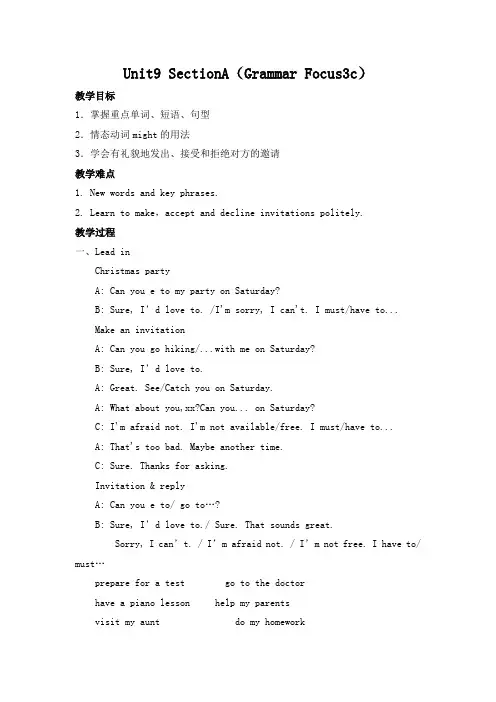
Unit9 SectionA(Grammar Focus3c)教学目标1.掌握重点单词、短语、句型2.情态动词might的用法3.学会有礼貌地发出、接受和拒绝对方的邀请教学难点1. New words and key phrases.2. Learn to make,accept and decline invitations politely.教学过程一、Lead inChristmas partyA: Can you e to my party on Saturday?B: Sure, I’d love to. /I'm sorry, I can't. I must/have to...Make an invitationA: Can you go hiking/...with me on Saturday?B: Sure, I’d love to.A: Great. See/Catch you on Saturday.A: What about you,xx?Can you... on Saturday?C: I'm afraid not. I'm not available/free. I must/have to...A: That's too bad. Maybe another time.C: Sure. Thanks for asking.Invitation & replyA: Can you e to/ go to…?B: Sure, I’d love to./ Sure. That sounds great.Sorry, I can’t. / I’m afraid not. / I’m not free. I have to/ must…prepare for a test go to the doctorhave a piano lesson help my parentsvisit my aunt do my homeworkA: Can he/she/they e to …?B: No, he/ she/ they can’t.He/ She/ They (might) have (has) to/ must…Grammar Focus3aplete the answers with might and one of the phrases in the box.watch TV on the weekend my cousin visit grandparentspractice the violin1. A: What are you going to do on Saturday?B: I'm not sure. I might ________________________2. A: What are you planning to do after school?B: I don't know. ______________________________3. A: When will you finish the science homework?B: __________________________________________4. A: Who are you going to the movies with?B: __________________________________________5. A: Are you free to e to my place on Saturday?B: __________________________________________3bplete the sentences below. Use the words in brackets to help you.1.Inviting:________________________ (can/play tennis)Accepting:_____________________2. Inviting: _________________________________________ (would like to/ go to the movies)Refusing: ____________________Reason: ___________________________________ (might have to)3. Inviting: _____________________________ (can/ hang out with us tonight)Refusing: ___________________Reason: _________________________(must)4. Inviting: __________________________________________ (would like to/e to my birthday party)Accepting:_____________________.2 You get these invitations but can't go. Write a refusal and areason.1. Invitation: "Can you e to my party on Saturday?"2. Invitation: "Let's go to the movies tomorrow night."3. Invitation: "Let's go to the concert on the weekend."4. Invitation: "Do you want to go shopping with me next week?"5. Invitation: "Can you play soccer with me after school today?"1. I’d like you to _________ (邀请) to dinner.2. They didn’t _________ (接受) his money.3. The girl __________ (拒绝) his invitation.4. Go straight down the street _______(直到) you see the bank.5. _________(悬挂) your clothes on the line.6.He _________(go) home until he finished his work.7. I like to ______ ______(闲逛) at mall with my friends.8. I have to run to ________ (赶) the bus.课堂练习同学们做exercisesthank you。
Unit 9 Can you come to my party?Section A (1a-1c)1.重点单词:prepare,exam,flu2.重点短语:prepare for an exam,have the flu3.重点句式:—Can you come to my party on Saturday afternoon? —Sure,I'd love to./Sorry,I can't.I have to prepare for an exam. I'm sorry,too.I must go to the doctor.1.会用“Can you...?”来对别人发出邀请2.学会接受和拒绝对方的邀请1.熟练掌握情态动词can的用法2.学会有礼貌地发出、接受和拒绝对方的邀请一、预习课本P65新单词并背诵,完成下面的汉译英。
1.准备____________ 2.考试____________3.流感____________二、认真预习1a-1c,找出下列短语和句型。
1.准备考试____________________2.患流感____________________3.你能在星期六的下午参加我的聚会吗?当然了,我非常乐意去。
/抱歉我不能。
我必须要准备考试。
/ 我也很抱歉,我必须去看医生。
________________________________________________________________________Step 1情景导入Teacher:I'm very happy today,because it is my birthday tomorrow,and I am going to have a birthday party.Would you like to come to my party?Students:Yes,we'd love to.Teacher:Welcome to my party.But do you know another way of saying “Would you like to come to my birthday party”?You don't need to be worried,today we will learn it.Now let's learn “Unit 9 Can you come to my party?”.环节说明:由过生日邀请学生参加生日聚会引出将要学习的新句型,过渡自然,简洁明了。
课堂内容呈现:一、简介1、结构:can + 动词原形,没有人称和数的变化。
2、否定形式:cannot/can’ t, cannot比缩略形式can’ t要正式。
口语中一般用缩略形式。
例如:I can swim.Daming can ride a bike. He can’t drive a car.二、用法1、表示能力(体力、知识、技能等),此时可用be able to代替。
例如:Mary can speak three languages. 玛丽会说三种语言。
= Mary is able to speak three languages.注意:(1)can只有一般现在时和一般过去式;而be able to则有更多的时态。
例如:I’ll not be able to come this afternoon. 今天下午我将会来。
***(2)当表示“经过努力才得以做成功某事”时应用be able to,不能用can。
例如:He was able to go to the party yesterday evening in spite of the heavy rain. 尽管很大雨,他昨天能来参加聚会。
2、表示请求和允许。
例如:---Can I go now?--- Yes, you can. / No, you cannot/can’t.此时可与may互换。
在疑问句中还可用could,might(不可用于肯定句、否定句或答语)代替,不是过去式,只是语气更委婉。
例如:--- Could I come to see you tomorrow?--- Yes, you can. ( No, I’m afraid not. )3、表示可能性猜测。
例如:The man over there can´t be my uncle. My uncle has gone to Beijing. 那个人不可能是我的叔叔。
语法互动(九)系动词和情态动词中考考点1.系动词be, look, smell, get, become, turn, keep等的基本用法。
2.含情态动词can, must, need, may等的基本句型结构及其用法。
考点一系动词(linkv.)系动词本身有意义,但不能独立作谓语,必须与表语一起构成谓语,称作“系表结构”,说明主语的状态、性质、特征或身份。
常见的系动词:be(是), look(看起来), ______(似乎), appear(显得), ______(觉得,摸起来), become(变得,成为), get(变得), sound(听起来), ______(闻起来), taste(尝起来), turn(变得), grow(渐渐变得),keep/stay(保持), remain(保持不变)等。
(1)can表示能力、可能性、允许等意义。
could是can的过去式。
Anybody can make mistakes. 任何人都可能会犯错误。
He can't be in the room.他不可能在房间里。
【注意】can/could表推测时,常用于否定句或疑问句中。
(2)can引导的疑问句,回答用can; could表示“过去的能力”引导的疑问句,回答用could,could也可表示现在时态,用于委婉地提出请求、建议等,回答用can。
—Could you show me the way to the hospital?你能告诉我去医院的路吗?—Of course I can.当然可以。
(3)be able to表示“某人做某事的能力”,可用于任何时态。
He was able to flee to Europe before the war broke out. 战争爆发前,他成功地逃到了欧洲。
2.may和might的用法(1)表示允许或请求时,might比may语气更委婉;might通常用于疑问句中。
Unit 9 Can you come to my party?课时教学设计第一课时Section A (1a-2d)1.通过看图说话、师生问答、听录音、角色扮演等形式,使学生掌握本课时的单词prepare,exam,flu,available,until,hang,catch,以及短语hang out,another time,prepare for;让学生学会发出邀请、接受邀请和拒绝邀请。
2.通过师生问答、角色扮演、调查采访、做游戏等形式,使学生学会“Can you come to my party on Saturday afternoon?”“Sure,I'd love to.”“Can you go to the movies on Saturday?”“I'm afraid not.I have the flu.”等句子;学会谈论自己的计划和安排,同时巩固情态动词can和have to的用法及现在进行时态表将来的用法。
重点掌握邀请他人参加活动、接受或拒绝他人邀请的句型。
难点情态动词can和have to的用法;现在进行时态表将来的用法。
Step 1 情景导入通过自由交际进行复习热身。
For example:T:I'm very glad to see you again.Boys and girls! My birthday is coming. I am having a paty.Do you like parties?Ss:Yes.T:What can you do at a party?S1:I can dance.S2:I can sing.S3:I can play games.S4:I can meet some new friends.S5:I can talk with my friends.T:I am glad you can do so many things.Can you help me prepare for it?Ss:Of course.T:Thank you.Can you come to my party?You can say,“Sure,I'd love to.”If you can't come,you can say,“I'm sorry,I can't.I have to do…”or “I'm sorry,I can't.I'm doing…”Ss:Yes.(设计意图:通过师生自由交际复习热身并导入新课,谈论如何发出邀请、接受邀请和拒绝邀请,激发学生的学习兴趣。
自主学习方案1.自学生词,并记住拼读及拼写。
2.预习课本,找出重点短语和句子。
(见学案自学导练内容)3.读记后完成自学导练内容。
课堂导学方案Step 1 情景导入(2分钟)教师通过师生自由交流,导入本节课的话题。
T:Hi, class, I will have a party at home tomorrow .Can you come to my birthday party?S1: Sure, I’d love to.S2:Sorry,I can’t .I have to …(学生列举原因)如:I have to prepare for my English exam.I have to help my parents with housework.I have to look after my baby sister.I have to meet my friend at the station.I am ill.I have the flu.…环节说明:由过生日邀请学生参加生日聚会引出将要学习的新句型,过渡自然,简洁明了。
Step 2 完成教材1a—1c的任务1.教师通过读音规则和构词法,引导学生记忆词汇的音、形、意。
(学生领读)(3分钟)如:prepare for=get ready for, exam=examination ,flu=cold ,available=free2.学生听1b的录音,完成1b任务。
(3分钟)3.核对答案。
(单独提问与集体回答相结合)(2分钟)4.教师让学生根据1c提供的信息编写对话,练习新的目标句型“Can you come to my party?”及肯定回答和否定回答。
(利用1a的短语)(5分钟)5.小结训练。
(3分钟)(D)(1)I usually watch TV with parents _____ Sunday evening.A.inB.atC.forD.on(C)(2)—What is your mother doing?—She is preparing ____ dinner for us.A.inB.atC.forD.to(B)(3)—Can you come to my birthday party?—____________.A.Yes,I doB.Sorry,I can’tC.No,I’d love toD.Sorry,I don’t(4)他得流感了,不得不去看医生。
英语情态动词的用法教案一、教学目标1、学生能够理解并掌握常见情态动词(can, could, may, might, must, shall, should, will, would)的基本含义和用法。
2、学生能够正确运用情态动词来表达能力、可能性、许可、义务、建议等意义。
3、学生能够在语境中准确判断和使用恰当的情态动词,提高语言表达的准确性和恰当性。
二、教学重难点1、重点(1)掌握常见情态动词的基本含义和用法。
(2)能够区分不同情态动词在表达相似意义时的细微差别。
2、难点(1)情态动词在虚拟语气中的用法。
(2)根据具体语境灵活运用情态动词。
三、教学方法1、讲授法:讲解情态动词的基本概念和用法规则。
2、练习法:通过练习题巩固所学知识。
3、情景教学法:创设具体情境,让学生在实际情境中运用情态动词。
四、教学过程1、导入(5 分钟)通过展示一些包含情态动词的句子,如“I can swim” “You must finish your homework on time” 等,引导学生观察这些句子,提问学生对这些句子中情态动词的理解,从而引出本节课的主题——英语情态动词的用法。
2、知识讲解(25 分钟)(1)Can 和 couldCan 表示能力、可能性、许可等。
例如:“I can speak English”(能力)“It can rain tomorrow”(可能性)“You can go now”(许可) Could 是 can 的过去式,用于过去时态中,但 could 也可以用于现在时态,语气比 can 更加委婉。
例如:“Could you help me?” (委婉请求)(2)May 和 mightMay 表示许可、可能性。
例如:“May I come in?” (许可)“It may be sunny tomorrow” (可能性)Might 是 may 的过去式,语气比 may 更加不确定和委婉。
授课教案
学员姓名:____ 授课教师:杨老师所授科目:英语
学员年级:上课时间: ________ 年月日时分至时_______________________ 共小时
1)表允许,请求二can
need既可用作情态动词,也可用作实义动词。
用作情态动词时,用作实义动词时,可用于各种句式。
1) .用作情态动词,用于否定句和疑问句中。
a) .Need I ….? Yes , you must / No, you needn ' t . Need we finish the work today ?Yes you __?
A.need
B.can
C. may
D.must
b) . need + do sth .变否定句:n eed n' t do sth
变疑问句:Need sb do sth ?
2) .用作实义动词
a) . need + to do sth . We n eed _____ (buy) some school things . 变否定句:don' t /doesn' t /didn ' t +need to do sth .
变疑问句:Do / Does /Did sb + n eed to sth ?
Yes , … do/ does / diN o, sb don ' t / doesn ' t /didn ' t . You don ' t need to do it yourself.
b) .当主语是物时。
Sth + need + doing sth = Sth +need to be done . The table n eeds pain ti ng . =The table n eeds ________________ .
5.had better 的用法
1) . had better + 动词原形=It' s best to do sth .
You had better _____ (stay )at home . =
__________________ stay at home .
2) . Had better n ot + 动词原形
We had better________ (not play ) the computer games .
6.must 与have to
Y es, please. / Certai nly 疑问句中must改为
主要否定句或疑问句中
(内在原因)have to “必须,不得不”强调客观需要,即外界因素迫使某人不得不干某事。
(外界原
因)。